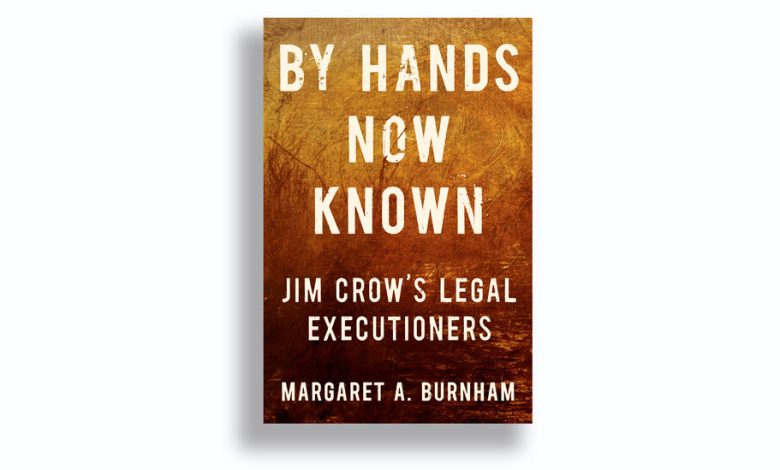Jim Crow’s Forgotten History of Homicides

BY HANDS NOW KNOWN: Jim Crow’s Legal Executioners, by Margaret A. Burnham
As far as we know, there are only two surviving documents that account for a death that took place in a jail cell in St. Augustine, Fla., on the evening of Oct. 20, 1945.
One is a death certificate: It states that an “accident” was “caused” by a man “resisting officers of the law,” which led to him “being hit” by an officer with a blackjack. The other is a letter to the New York office of the N.A.A.C.P. from the organization’s St. Augustine branch. The letter describes a man getting bludgeoned to death in front of other detainees, and requests an investigation into the “untimely death of our brother George Floyd whom we believe to have met his death unjustifiably so.”
The discovery of this George Floyd — a Black man who was killed by a police officer 75 years before another Black man with the same name was killed by a police officer — “was not entirely unforeseeable,” Margaret A. Burnham writes in “By Hands Now Known.” More than a decade ago, Burnham, a law professor, founded the Civil Rights and Restorative Justice Project at Northeastern University, and with the help of the political scientist Melissa Nobles created a database of what Burnham calls a “forgotten history of racially motivated homicides” in the American South during the Jim Crow era. Burnham and Nobles collected whatever information they could find, interviewing descendants to learn about instances of racial violence that had been “largely ignored” in official accounts.
The death of George Floyd in 1945 was one such tragedy. It “destroyed his family,” Burnham writes. The fact that he shared a name with a man who died in analogous circumstances in 2020 speaks to how “quotidian” such violence was — entrapping so many Black Americans in its grip.
Even as more attention finally gets paid to the kind of brazen mob violence that included the lynching of Black people and the burning of entire neighborhoods to the ground, “By Hands Now Known” draws on the research of the Civil Rights and Restorative Justice Project to do something else. What Burnham seeks to show is the “chronic, unpredictable violence” that shaped daily life in the South — “how lethal, for women and for men, the most commonplace encounters under Jim Crow could be.”
The book opens with the story of an elderly Black woman in Donalsonville, Ga., who was beaten to death by a young white shopkeeper with an ax handle, in 1944. What took place in that shop before he attacked her? “We are left to speculate on details,”Burnham writes; a letter to the N.A.A.C.P. “was all that kept this incident from disappearing into thin air.”
Recounting such stories is part of the important work that this book does, offering evidence as a rejoinder to decades of “manufactured uncertainty.” According to firsthand accounts, the hips of one victim “looked like battered liver”; the head of another was as “soft as a piece of cotton.” The acts of brutality are especially grotesque when recounted next to any so-called precipitating event: laughing at a friend’s joke; selling lottery tickets; complying with a police officer’s demands by saying “yes” instead of “yes, sir.”
But historical retrieval is only part of Burnham’s goal with this book, which also makes a case for reparations, to pick up “where law has failed.” And the law did fail. What one Supreme Court justice called “our federalism” was frequently deployed to protect not people’s constitutional rights but “local regimes of racial terror,” Burnham writes.
In the Jim Crow South, authoritarianism prevailed. Burnham emphasizes mobility, or the right of people to move as they choose. Extradition laws meant that even the act of leaving the South for the North wasn’t so simple. Burnham resurfaces examples of Southern states deploying trumped-up charges and technicalities to force the return of Black people who left for Northern cities like Detroit. Some Northern officials refused to comply, pointing out the difficulty of ensuring a fair trial in the Jim Crow South for a Black defendant, not to mention what Burnham describes as “a looming lynch mob.” One lawyer called a requisition attempt by Georgia “the 1939 edition of the ‘Fugitive Slave Law.’”
“By Hands Now Known” includes several chapters about American soldiers during World War II who were harassed and even killed by bus drivers in the South. Some soldiers resisted segregated transportation “boldly and directly”; others were met with paroxysms of rage for what seemed to be little more than being a Black man in military uniform.
Jim Crow undermined the ability of the War Department to do something as basic as provide for the safety of its soldiers on American soil. Still, the federal government continued to defer to Southern rules. Even when the War Department referred civil rights matters — including homicides — to the Justice Department, Burnham says that there is no record she could find of the Justice Department prosecuting a single case over the course of the war.
Each death in this book is recounted with intensity and specificity, but some patterns do emerge. Many of the victims in this book were only one or two generations removed from slavery; a number of them were missing death certificates, or were buried in graves unknown. Some of the white people who killed them lived long lives; few were held to account.
With justice so elusive, even a simple acknowledgment of the facts is a necessary step. As some of the survivors put it when they first heard from Burnham and her team: “I thought I’d never get this call.”
BY HANDS NOW KNOWN: Jim Crow’s Legal Executioners | By Margaret A. Burnham | Illustrated | 328 pp. | W.W. Norton & Company | $30




